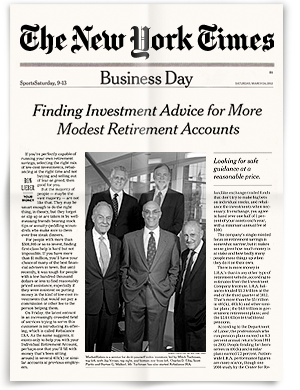Investing for 2016 in an Expensive Market

In his annual Wall Street Journal start-of-the-year stock market analysis, Rebalance Investment Committee member Professor Burton Malkiel explains how best to invest for 2016 in an “expensive” market.
How do you invest when everything is expensive? U.S. stocks are selling at more than 25 times their cyclically adjusted earnings. Bond yields are unusually low (the 10-year U.S. Treasury yields about 2.25%), and interest rates are likely to rise. Money-market funds and savings deposits yield next to nothing. Property markets are also richly valued. There are no “door busters” available in world financial markets. Fortunately, investors who set modest goals and follow timeless lessons will do fine and be able to sleep well at night knowing that their risk is contained.
First, remember that money set aside for fixed future expenditures (like the college tuition bill) needs to be put into perfectly safe, fixed- dollar investments, even if you need a microscope to find a yield. Here government-guaranteed certificates of deposit at Internet banks will at least let you realize a 1.25% return.
For longer-term retirement savings, the key to reducing risk is to diversify broadly (stocks, bonds, real estate, domestic and international) and over time. Also important is to reinvest regularly dividends and interest payments and save some amount each pay period to a retirement plan. In addition, control your costs and minimize your tax bill.
Index funds and exchange-traded funds not only have rock-bottom expenses but they also tend to be quite tax efficient, since they trade infrequently. Volatile asset prices also present some opportunities. Selling one broad-based index fund to realize a capital loss, while replacing it with another fund that is tied to a different index, retains an investor’s long position in the asset class while realizing important tax savings.
Broad diversification remains the surest method to minimize investment risks. This means that U.S. investors need to overcome their home-country bias and put money into international securities. Domestic markets often behave differently than international ones, and broad equity portfolios tend to be more stable over time than narrow ones. Fixed-income securities, including preferred stocks, need to be included to anchor your portfolio despite their low current yields. And real-estate returns, which have historically experienced close to a zero correlation with bond returns, provide excellent diversification.
Within their equity and bond portfolios, investors should ensure that they have some exposure to those parts of the market that are currently unpopular but that are attractively priced, relatively speaking.
Perhaps the most useful metric to assess valuations is the cyclically adjusted price-earnings multiple (CAPE). This is the ratio of today’s market price to a measure of average earnings over recent economic cycles. CAPEs for broad stock-market indexes do not help in predicting returns one year ahead. But they do have a reasonably high correlation with average returns over, for example, the next five to 10 years.
Today the CAPE stands at over 26 for the U.S. market, well above its long-run average. The CAPE is 20 for Japan, 15 for Europe and under 10 for emerging markets—below their long-run averages. I am not suggesting that you try to time the markets and shift from one to another based on these metrics. But I do suggest that if your equity portfolio is composed entirely of U.S. stocks, you might add some foreign stocks in 2016.
Bond portfolios should also be broadly diversified. Tax-exempt bonds are cheap relative to taxable bonds. The sharp price declines recently in higher yielding corporate bonds have made them relatively attractive compared with U.S. government securities. A “total bond market” portfolio has about two-thirds of its holdings in U.S. Treasury and government agency bonds and doesn’t provide much exposure to the riskier parts of the market.
Bond investors should resist the temptation to sell all their bonds to avoid price declines as interest rates rise. The rise in rates is likely to be less sharp than some investors fear, and excess capacity world-wide will probably keep a lid on inflation for some time. Moreover, bondholders who reinvest their coupons and replace maturing bonds with higher yielding securities will find that rising rates will ultimately be beneficial.
U.S. securities markets are highly priced at the start of 2016, and future returns will most likely be lower than in the past. But the timeless lessons—keep invested, don’t try to time the market, and diversify broadly—remain the best guide for investors.
Mr. Malkiel, Investment Committee member of Rebalance, is the author of “A Random Walk Down Wall Street” (W.W. Norton), now in its 11th edition.






